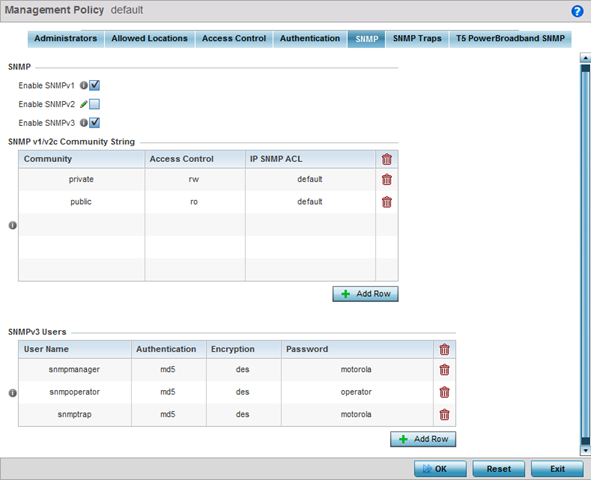Controller, service platform and access point managed networks use SNMP trap receivers for fault notifications. SNMP traps are unsolicited notifications triggered by thresholds (or actions), and are an important fault management tool.
A SNMP trap receiver is the defined destination for SNMP messages (external to the controller,service platform or access point). A trap is like a Syslog message, just over another protocol (SNMP). A trap is generated when a device consolidates event information and transmits the information to an external repository. The trap contains several standard items, such as the SNMP version, community etc.
SNMP trap notifications exist for most operations, but not all are necessary for day-to-day operation.
To define a SNMP trap configuration for receiving events at a remote destination:
Select the SNMP Traps tab.

Select the Enable Trap Generation checkbox to enable trap generation using the trap receiver configuration defined. This feature is disabled by default.
Refer to the Trap Receiver table to set the configuration of the external resource dedicated to receive trap information. Select Add Row + as needed to add additional trap receivers. Select the Delete icon to permanently remove a trap receiver.
|
IP Address |
Sets the IP address of an external server resource dedicated to receive SNMP traps on behalf of the controller, service platform or access point. |
|
Port |
Set the virtual port of the server resource dedicated to receiving SNMP traps. The default port is port 162. |
|
Version |
Sets the SNMP version to use to send SNMP traps. SNMPv2 is the default. |
| Trap Community | Provide a 32 character maximum trap community string. The community string functions like a user id or password allowing access to controller or access point resources. If the community string is correct, the controller or access point provides with the requested information. If the community string is incorrect, the device controller or access point discards the request and does not respond. Community strings are used only by devices which support SNMPv1 and SNMPv2c. SNMPv3 uses username/password authentication, along with an encryption key. The default setting is public. |
Select OK to update the SNMP Trap configuration. Select Reset to revert to the last saved configuration.